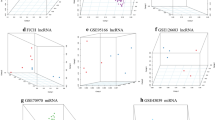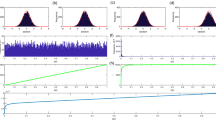Abstract
The nasopharyngeal cancer is a common cancer among southern Chinese. In order to better understand molecular mechanism of recurrent nasopharyngeal cancer (rNPC), we used DNA microarray to identify down-regulated tumor suppressed genes (TSGs) in rNPC, and bioinformatics to analyze their chromosomal localizations and molecular functions. Eight non-recurrent nasopharyngeal cancer (nNPC) and six rNPC tissue samples were selected, and Affymetrix Gene1.0 ST chips were used to construct the expression profiling of each tissue sample. Identify the down-regulated TSGs in rNPC by comparing expression profiling data of two type tissue samples. A total of five TSGs were identified to be down-regulated in rNPC. These five TSGs include SERPINF1, TPD52L1, FBLN1, RASSF6, and S100A2, and Signal Log Ratio were −2.2, −2.3, −3.5, −3.9 and −6.9 respectively. Chromosomal localization analysis showed that S100A2, RASSF6, TPD52L1, SERPINF1, and FBLN1 were located on chromosomes 1q, 4q, 6q, 17p and 22q, respectively. Functional analysis showed that SERPINF1 and TPD52L1 belonged to enzyme activity genes, S100A2 and FBLN1 belonged to calcium ion binding genes, RASSF6 belong to protein binding genes. Five TSGs likely to be the candidate TSGs involved in rNPC, and may play important roles in occurrence of rNPC. Chromosomes 1q, 4q, 6q, 17p and 22q may be considered as important region for screening TSGs that may relevant to rNPC. Those genes and chromosomal region need to be further studied.



Similar content being viewed by others
References
Hildesheim A, Levine PH (1993) Etiology of nasopharyngeal carcinoma: a review. Epidemiol Rev 15:466–485
Lengyel E, Baricza K, Somogyi A, Olajos J, Papai Z, Godeny M et al (2003) Reirradiation of locally recurrent nasopharyngeal carcinoma. Strahlenther Onkol 179:298–305
Zhou X, Cui J, Macias V, Kajdacsy-Balla AA, Ye H, Wang J et al (2007) The progress on genetic analysis of nasopharyngeal carcinoma. Comp Funct Genomics 2007:57513
Shao J, Li Y, Wu Q, Liang X, Yu X, Huang L et al (2002) High frequency loss of heterozygosity on the long arms of chromosomes 13 and 14 in nasopharyngeal carcinoma in southern China. Chin Med J (Engl) 115:571–575
Hu LF, Eiriksdottir G, Lebedeva T, Kholodniouk I, Alimov A, Chen F et al (1996) Loss of heterozygosity on chromosome arm 3p in nasopharyngeal carcinoma. Genes Chromosomes Cancer 17:118–126
Xiong W, Zeng ZY, Xia JH, Xia K, Shen SR, Li XL et al (2004) A susceptibility locus at chromosome 3p21 linked to familial nasopharyngeal carcinoma. Cancer Res 64:1972–1974
Hui ABY, Lo KW, Leung SF, Choi PHK, Fong Y, Lee JCK et al (1996) Loss of heterozygosity on the long arm of chromosome 11 in nasopharyngeal carcinoma. Cancer Res 56:3225
Huang Z, Li W, Du J, Huang Y, Tan Y, Fang W et al (2009) Research on differentially expressed genes in primary and relapsed nasopharyngeal carcinoma by DNA microarray. J Wenzhou Med Coll 39:568–571 (Article in Chinese)
Huang Z, Li W, Lin S, Huang Y, Du J, Tan Y et al (2010) Identification of differentially expressed genes in recurrent nasopharyngeal carcinoma and analysis of their chromosomal location. Chin J Otorhinolaryngol Head Neck Surg 45:47–51 (Article in Chinese)
Fang Y, Guan X, Guo Y, Sham J, Deng M, Liang Q et al (2001) Analysis of genetic alterations in primary nasopharyngeal carcinoma by comparative genomic hybridization. Genes Chromosomes Cancer 30:254–260
Hui AB, Lo KW, Leung SF, Teo P, Fung MK, To KF et al (1999) Detection of recurrent chromosomal gains and losses in primary nasopharyngeal carcinoma by comparative genomic hybridisation. Int J Cancer 82:498–503
Hui AB, Lo KW, Teo PM, To KF, Huang DP (2002) Genome wide detection of oncogene amplifications in nasopharyngeal carcinoma by array based comparative genomic hybridization. Int J Oncol 20:467–473
Zeng Z, Zhou Y, Zhang W, Li X, Xiong W, Liu H et al (2006) Family-based association analysis validates chromosome 3p21 as a putative nasopharyngeal carcinoma susceptibility locus. Genet Med 8:156–160
Chan AS, To KF, Lo KW, Mak KF, Pak W, Chiu B et al (2000) High frequency of chromosome 3p deletion in histologically normal nasopharyngeal epithelia from southern Chinese. Cancer Res 60:5365–5370
Chan AS, To KF, Lo KW, Ding M, Li X, Johnson P et al (2002) Frequent chromosome 9p losses in histologically normal nasopharyngeal epithelia from southern Chinese. Int J Cancer 102:300–303
Cheng Y, Lung HL, Wong PS, Hao DC, Man CS, Stanbridge EJ et al (2004) Chromosome 13q12 region critical for the viability and growth of nasopharyngeal carcinoma hybrids. Int J Cancer 109:357–362
Cheung AK, Lung HL, Ko JM, Cheng Y, Stanbridge EJ, Zabarovsky ER et al (2009) Chromosome 14 transfer and functional studies identify a candidate tumor suppressor gene, mirror image polydactyly 1, in nasopharyngeal carcinoma. Proc Natl Acad Sci USA 106:14478–14483
Tsuchiya T, Nakahama K, Asakawa Y, Maemura T, Tanaka M, Takeda S et al (2009) The reduction in pigment epithelium-derived factor is a sign of malignancy in ovarian cancer expressing low-level of vascular endothelial growth factor. Gynecol Endocrinol 25:104–109
Cho S, Ko HM, Kim JM, Lee JA, Park JE, Jang MS et al (2004) Positive regulation of apoptosis signal-regulating kinase 1 by hD53L1. J Biol Chem 279:16050–16056
Allen NP, Donninger H, Vos MD, Eckfeld K, Hesson L, Gordon L et al (2007) RASSF6 is a novel member of the RASSF family of tumor suppressors. Oncogene 26:6203–6211
Xie L, Palmsten K, MacDonald B, Kieran MW, Potenta S, Vong S et al (2008) Basement membrane derived fibulin-1 and fibulin-5 function as angiogenesis inhibitors and suppress tumor growth. Exp Biol Med (Maywood) 233:155–162
Zhang X, Hunt JL, Shin DM, Chen ZG (2007) Down-regulation of S100A2 in lymph node metastases of head and neck cancer. Head Neck 29:236–243
Acknowledgments
This study was funded by Zhejiang Science and Technology Agency (No.2007C23G2090017), Zhejiang P.R. China.
Author information
Authors and Affiliations
Corresponding author
Rights and permissions
About this article
Cite this article
Huang, Z., Li, W., Lin, S. et al. Identification of Novel Tumor Suppressor Genes Down-Regulated in Recurrent Nasopharyngeal Cancer by DNA Microarray. Indian J Otolaryngol Head Neck Surg 66 (Suppl 1), 120–125 (2014). https://doi.org/10.1007/s12070-011-0359-7
Received:
Accepted:
Published:
Issue Date:
DOI: https://doi.org/10.1007/s12070-011-0359-7




